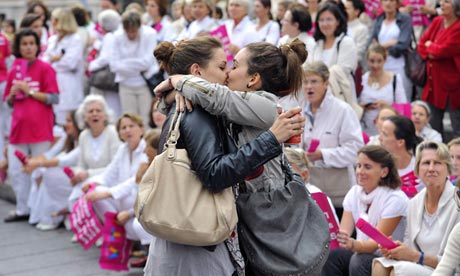How Gay Was Gore Vidal? Daily Beast
Sure he had sex with men, but just try to call him gay to his face. A year after the famous writer’s death his biographer Tim Teeman reveals new details about his balance between studied public ambivalence and his enthusiastic private behavior.
When I visited Gore Vidal’s home in the Hollywood Hills, five months after his death, one book, left unshelved, jolted me: The Mayor of Castro Street, Randy Shilts’s acclaimed biography of Harvey Milk, the inspirational gay San Francisco city supervisor assassinated in 1978. While Milk and Shilts were openly gay in rougher times, Vidal’s sexuality occupied a more vexed, undeclared place. Like both men Vidal was arguably a gay radical and hero, although he would have hated the plaudit.

Vidal died a year ago today, aged 86, of complications from pneumonia, the culmination of a long, painful decline which had included alcoholism and dementia. His death precipitated a memorable correction in the New York Times, whose obituary initially stated Vidal and Howard Austen, his partner from 1950 to 2003, when Austen died, did not have sex. “According to Mr Vidal’s memoir, Palimpsest, they had sex the night they met, but did not sleep together after they began living together. It was not true that they never had sex.”
The New York Times shouldn’t feel embarrassed: this imperious lion of American letters delighted in sowing confusion about his sex life and sexuality. Vidal said he was bisexual, but his family and friends say he was gay. Vidal adamantly believed “gay” referred to a sexual act, not a sexual identity. When I interviewed him in 2009, in his last major newspaper interview for the Times of London, and suggested he could have been America’s first gay president, he replied, witheringly, “No, I would have married and had nine children. I don’t believe in these exclusive terms.”
There was the way of Right and Left and easy pieties, and then there was Vidal’s way. He said almost nothing about HIV and AIDS, even though his nephew Hugh, who died of AIDS, begged him to. “Gore didn’t think of himself as a gay guy,” says Vidal’s close friend and now-biographer Jay Parini. “It makes him self-hating. How could he despise gays as much as he did? In my company he always used the term ‘fags.’ He was uncomfortable with being gay. Then again, he was wildly courageous.” Fred Kaplan, who wrote a landmark biography of Vidal, says, “He was not interested in making a difference for gay people, or being an advocate for gay rights. There was no such thing as “straight” or “gay” for him, just the body and sex.”
For most of their lives together, Vidal referred to Austen as his friend. His true love, he claimed, was Jimmie Trimble, a boy he had known at prep school who died fighting at the Battle of Iwo Jima. Vidal slept with Anaïs Nin and enjoyed close friendships with women including Claire Bloom and Joanne Woodward. He and Austen had sex with hustlers, or “trade” as Vidal called the handsome, “straight-acting” young men he liked. Paying for sex appealed to Vidal because it meant with this, as with so much else in his life, he was in control. He was mostly the “top.” In bed as in life, no one was going to screw Gore Vidal.
Vidal loved sex, and gossiping about it: he estimated he had had sex with a thousand men before he was 25. He told his nephew Burr Steers he had successfully pursued and had sex with Fred Astaire when he first moved to Hollywood. Steers says, “He also told me Dennis Hopper had a lovely tuft of hair above his ass. He never told me how he knew that.” Another close friend of Vidal's revealed Vidal had asked, when hearing the friend was staying at the legendarily louche Chateau Marmont, "How is the Chateau?", before adding: "Brad Davis [star of Midnight Express and Querelle] was a beautiful boy and I fucked him on the bathroom floor of the Chateau Marmont." Davis, who was HIV-positive, died of a drug overdose in 1991.
In my book, In Bed With Gore Vidal: Hustlers, Hollywood and the Private World of an American Master, to be published in November, Vidal’s friends and family talk about not just the sex Vidal had and with whom, but the roots of his complex attitude towards sexuality and love which lay in a fractured upbringing, and why his refusal to be defined was as personal as it was intellectual. He may have been “post-gay” before his time, but Vidal was also of his time—when being “gay” meant being effeminate, an outsider, without power. Vidal did not identify with any of those positions and wasn’t in thrall to the equality movement. He had grown up around power—his much-loved grandfather was a senator—and he coveted his relationship with John and Jackie Kennedy (whom he was related to) before they fell out, he claimed because Bobby Kennedy believed Vidal’s sexuality could become a White House embarrassment.
In bed as in life, no one was going to screw Gore Vidal.
Vidal was defiant, but also cowed, in his sexuality. His resistance to being known as gay was in some ways old-school: he felt it could be used to diminish him, yet he didn’t play the overt heterosexual like the secretly gay or bisexual celebrities of the day, like Cary Grant and Walter Pidgeon. Indeed Vidal was the radical who wrote The City and the Pillar in 1948, one of the first modern novels about homosexuality, which made him famous even though he also felt it led to him being blacklisted and destroyed his chances of a political career. This may seem contradictory, but at different times Vidal was proud of his early success and bitter that it had marked him out somehow. If he wouldn’t define himself, others were not so subtle. In 1968 Vidal was famously called a “queer” on television by the conservative author and commentator William F. Buckley. An interminable legal case unfolded between them, Vidal convinced and genuinely afraid, I discovered, that Buckley had evidence he had had sex with underage boys.
Yet Vidal, while not declaring anything, didn’t hide: he bought a transsexual heroine to life in Myra Breckinridge (1968) and wrote essays against sexual repression and in favor of sexual equality. Weeks after the Stonewall Riots in 1969, the campaign group the Mattachine Society wrote to Vidal asking for financial support, with a bracing opening gambit: “I don’t think it is any secret to anyone that you are gay — most people seem to take it for granted—and it is on this basis that this appeal is being made to you, to help us lend a helping hand to your less fortunate brothers (or should I say ‘sisters’).”
Vidal caroused with Tennessee Williams and Christopher Isherwood and feuded with Truman Capote. He slept with Jack Kerouac at the Chelsea Hotel. His much-cherished years in Rome in the 1960s were a merry sexual circus. He had sex with hustlers in the afternoons, he said, so he could concentrate on conversation with friends in the evening.
One of Vidal’s oldest friends was Scotty Bowers, who had sex with, and procured sex for, celebrities including Cary Grant, Spencer Tracy, and Vidal himself. “Gore had a medium-sized cock, seven inches, he looked circumcised but wasn’t,” Bowers recalls. The few times Bowers had sex with Vidal was “pleasant, not mad love.” Vidal was always “on the ball, not bashful or shy, rather aggressive and pushy,” and was “more or less into a quick trick. He did everything sexually: you sucked his cock, he would suck yours, but he preferred to fuck. He was young and hot and sex was rather quick.”
After Austen’s death Vidal cried to one friend he had loved him. This was no “friendship,” but, as I sketch in the book, a deep, enduring relationship. Vidal’s sister Nina Straight remembers her half-brother becoming very upset was when, "sometime in the ‘50s or ‘60s" Vidal lost a tiny picture he carried in his wallet "of Howard as a little boy with bangs and Mary Jane shoes. He was really upset and saying, 'He's the only good person I've ever known’—‘good’ meaning simple, guileless — and he loved the image of that little boy, the basic, innocent dedication and purity.” Vidal’s family and friends view his lifelong devotion to Jimmie Trimble with incredulity, yet Vidal would gaze at Trimble’s portrait most nights before going to bed.
As Vidal grew frailer, Bowers bought men round “to just sit with him.” In December 2011, seven months before he died, Vidal, mind wandering, asked Bowers, “You suppose we could find Bob and bring him over?” “Bob” was Bob Atkinson, a favorite hustler of Vidal’s that Bowers had first set him up with 63 years previously. “Gore liked Bob because he had been in the Navy and he had a cock as big as a baby’s arm,” Bowers recalls.
All that sex, but he never worried about HIV and AIDS? I said to his nephew, Steers. “I think he was quite confident it was something that wouldn’t happen to him,” Steers replied. Because he thought he was at less risk of infection as he liked fucking men rather than being fucked? I asked. Steers laughed. “No. Because he was Gore Vidal.”
Tim Teeman’s “In Bed With Gore Vidal: Hustlers, Hollywood and the Private World of an American Master” will be published by Magnus Books in November.




